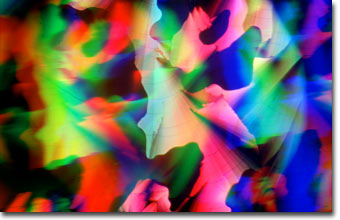Spike (M.I.) Walker
Sulphur Crystals
English photomicrographer Spike (M.I.) Walker has been a consistent winner of the Nikon Small World competition for many years and has published many articles and a book about microscopy. Featured below is a photomicrograph of sulphur crystals imaged between crossed polarizers through a diffraction grating.

|
A preparation of sulphur crystals (from the melt) was imaged between crossed polars with the assistance of a diffraction grating. A disk made from cleared base of Polachrome 35-millimeter film was placed at the back of a 4x/0.16 NA planapochromat objective to serve as the diffraction grating. The method is very time-consuming, and independent rotation of stage, polarizer/analyzer combination, and diffraction grating are useful if too much frustration is to be avoided. The microscope was a Zeiss Ultraphot lll coupled to an automatic 35-millimeter photohead. Photographed with Fujichrome Velvia. (10x) |
Sulphur is a nonmetallic chemical element belonging to the oxygen family (Group VIa of the periodic table) and is one of the most reactive of the elements. Pure sulfur is a tasteless, odorless, brittle solid that is pale yellow in color, a poor conductor of electricity, and insoluble in water. It was known to the ancients and referred to as brimstone in the Old Testament. Sulphur was first classified as an element in 1777 by Antoine Lavoisier and is estimated to be the ninth most abundant element in the universe. It makes up about 0.03 percent of the Earth's crust and is the most abundant constituent of minerals.
Free sulphur occurs primarily in volcanic or sedimentary deposits throughout the world, with heavy concentrations located in the sediments of the Gulf coast of North America. Sulphur compounds can be found in coal, petroleum, and natural gas and in sulfide ores such as pyrite (iron disulfide), galena (lead sulfide), cinnabar (mercury sulfide), sphalerite (zinc sulfide), and chalcopyrite (copper iron sulfide), as well as sulfates such as gypsum (calcium sulfate) and barite or heavy spar (barium sulfate).
